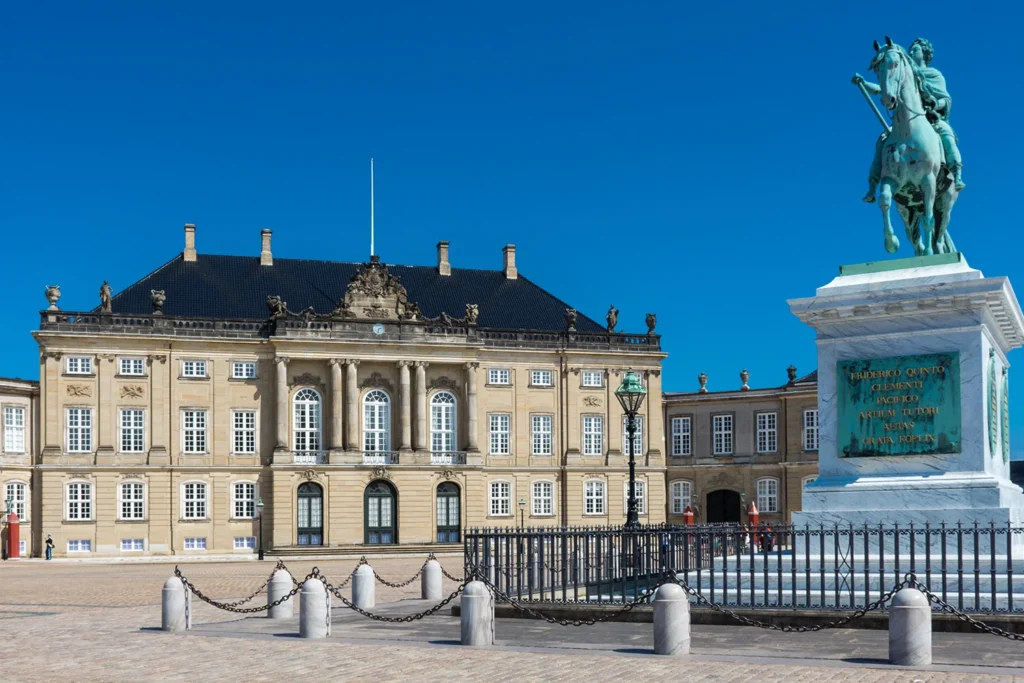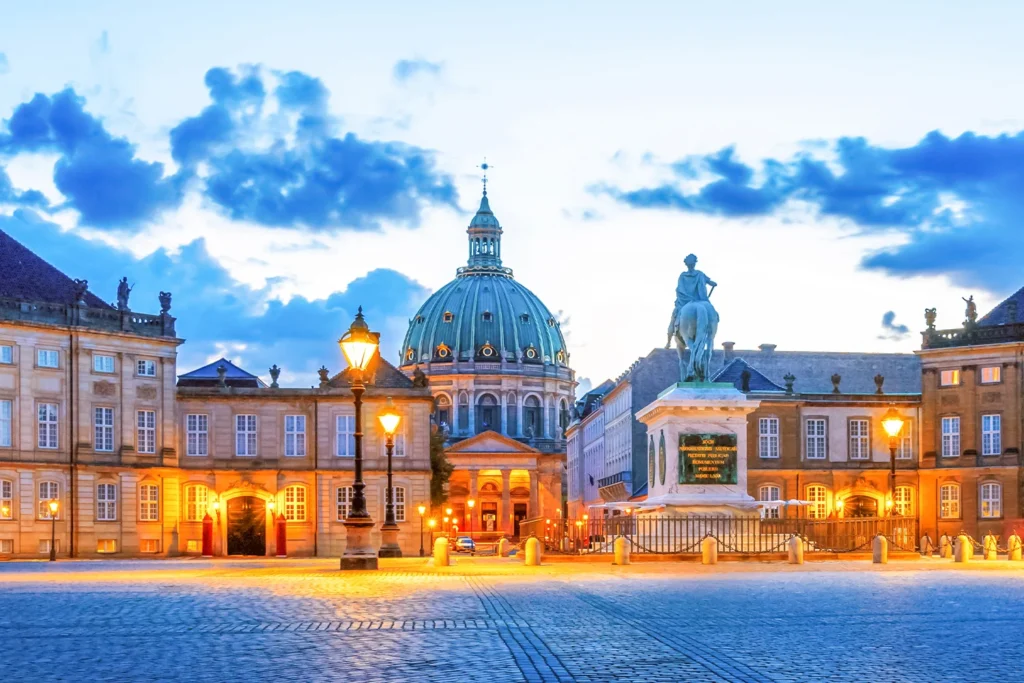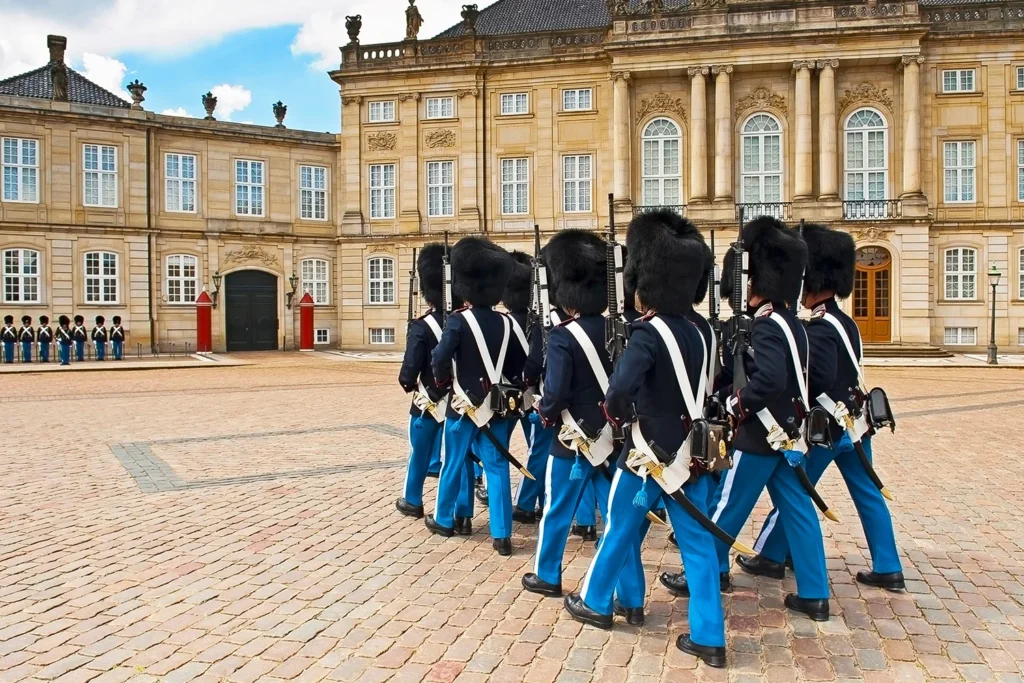To get a taste of royal life, you don’t need to plan a trip to the United Kingdom. The majestic residence of the Danish monarchs, located in the heart of Copenhagen, also offers tourists a glimpse into this world of grandeur.
Amalienborg is the main residence of the Danish royal family. It’s commonly referred to as a palace, but if you use that term, be prepared for plenty of corrections. After all, we’re not talking about just one, but four separate palaces that together form the palace complex.
The royal residence is often referred to as the “winter palace” because it is most frequently used by today’s representatives of the royal family during the winter season. This is likely why, not only in the summer season but practically all year round, the palace courtyard sees a steady flow of Danish and international tourists.
The Origins of Amalienborg Palace
The first building to stand where the current residence is located was actually a whim of Queen Sophie Amalie. In the 17th century, she commissioned a summer palace to be built here, and the palace complex takes its name from her. Unfortunately, the structure was only in use for a few years before it was consumed by a fire that started in a neighboring opera house.
In 1750, King Frederick V of Denmark decided to grant the land previously occupied by Queen Sophie Amalie’s summer residence to four Danish noblemen. However, this was not a simple gift. In exchange for the land, the aristocrats—Moltke, Levetzau, Brockdorf, and Løvenskiold—were required to build four identical residences on their plots, following the design of Nicolai Eigtved, the royal architect. Originally, the buildings were meant to be the centerpiece of the king’s new district in Copenhagen, Frederiksstaden. However, another tragedy forced the monarch to slightly alter his plans.
After the fire at the previous royal castle, Christiansborg, Frederick V came up with the idea of buying back the newly built residences from the noblemen. This is how, since 1794, the residential complex became the royal seat, and to this day, it remains home to members of the royal family.

The Structure of the Amalienborg Complex
The royal residence in Copenhagen consists of four identical rococo-style palaces arranged around an octagonal square. At the center of the courtyard, it’s hard to miss the striking monument—a statue of King Frederick V, the initiator of the palace complex’s construction. The equestrian statue depicts the monarch dressed in Roman imperial robes with a laurel wreath on his head. It took 20 years to complete the sculpture, with a budget that exceeded the cost of building the palaces themselves.
The statue and the Amalienborg courtyard wouldn’t be admired so frequently if not for the surrounding buildings, which together form the residence of the Danish royal family. These include:
- Moltke Palace – now called Christian VII’s Palace, the monarch’s ceremonial palace.
- Levetzau Palace – known as Christian VIII’s Palace, it is currently the residence of Prince Joachim and Princess Marie.
- Brockdorff Palace – known as Frederick VIII’s Palace, it serves as the private residence of the royal family.
- Schack Palace – although construction was initiated by the nobleman Løvenskiold, it was completed by Countess Anna Sophie Schack. Today, it’s referred to as Christian IX’s Palace and is most often used as the monarch’s winter residence.
Amalienborg Museum

Christian VIII’s Palace will especially interest those who dream of peeking behind the scenes of royal life, as it is home to the palace museum. The institution is primarily dedicated to the history of the Glücksburg dynasty, which has ruled Denmark since 1863. Entering its grounds is like stepping into the private chambers of monarchs. Thanks to the preserved apartments, you’ll travel back in time to the reign of Christian IX, Queen Louise, and their descendants.
The tour doesn’t end with just viewing the opulent interiors. The museum boasts a collection of nearly 6,000 artifacts. Items that once furnished the rooms and halls occupied by the royal family now leave museum guests in awe. Among the royal treasures are furniture, paintings, jewelry, and other personal items of former kings. You’ll also find one of the world’s most important collections of Russian jewelry. The palace rooms are filled with multimedia presentations as well, showcasing the history of the Danish monarchy.
To avoid queues and save some time, it’s worth purchasing tickets online (e.g. through this website). And if you want to dedicate even more time to uncovering the secrets of the Danish monarchy, consider buying a combined ticket, which grants entry to both the Amalienborg Museum and the Rosenborg Museum, dedicated to the Oldenburg dynasty.
The Changing of the Guard Ceremony
One of the main tourist attractions at Amalienborg Palace is the Changing of the Guard ceremony. Each of the four palaces is constantly guarded by royal guards dressed in black-and-blue historic uniforms. You’re unlikely to miss them, as their distinctive bearskin hats, known as busbies, catch the attention of all passersby.
Every day at precisely noon, you can witness the ceremonial march of the guards on the royal square, the handover of the special standard, and the changing of the guard. The ceremony is particularly grand when the monarch is in residence, as it is accompanied by a military band.

Searching Crowned Heads
Visitors to the palace often hope to catch a glimpse of the Danish monarchs near the royal residence. However, it’s not as easy as it might seem. The best chance to see the royal family is for those visiting Copenhagen on the king’s birthday. In the case of King Frederick X, that would be May 26th. According to tradition, on this day, he appears with his family on one of the balconies of the Amalienborg complex. It’s the perfect spot to greet the crowds gathered in the courtyard and thank them for their birthday wishes.
Of course, King Frederick X appears in the royal chambers more than once a year. The king’s presence at the palace is signaled by the raising of the Danish royal standard at Christian IX’s Palace. If you want to know whether the heir to the throne is currently at the palace, you should look for the crown prince’s standard flying proudly over Christian VIII’s Palace.
Practical information
- It is best to purchase tickets for the Amalienborg Palace in advance. This way, you can avoid standing in long lines and reduce the risk of tickets being sold out.
- Address: Amalienborg Slotsplads, 1257 København K, Denmark
- Buy tickets on GetYourGuide